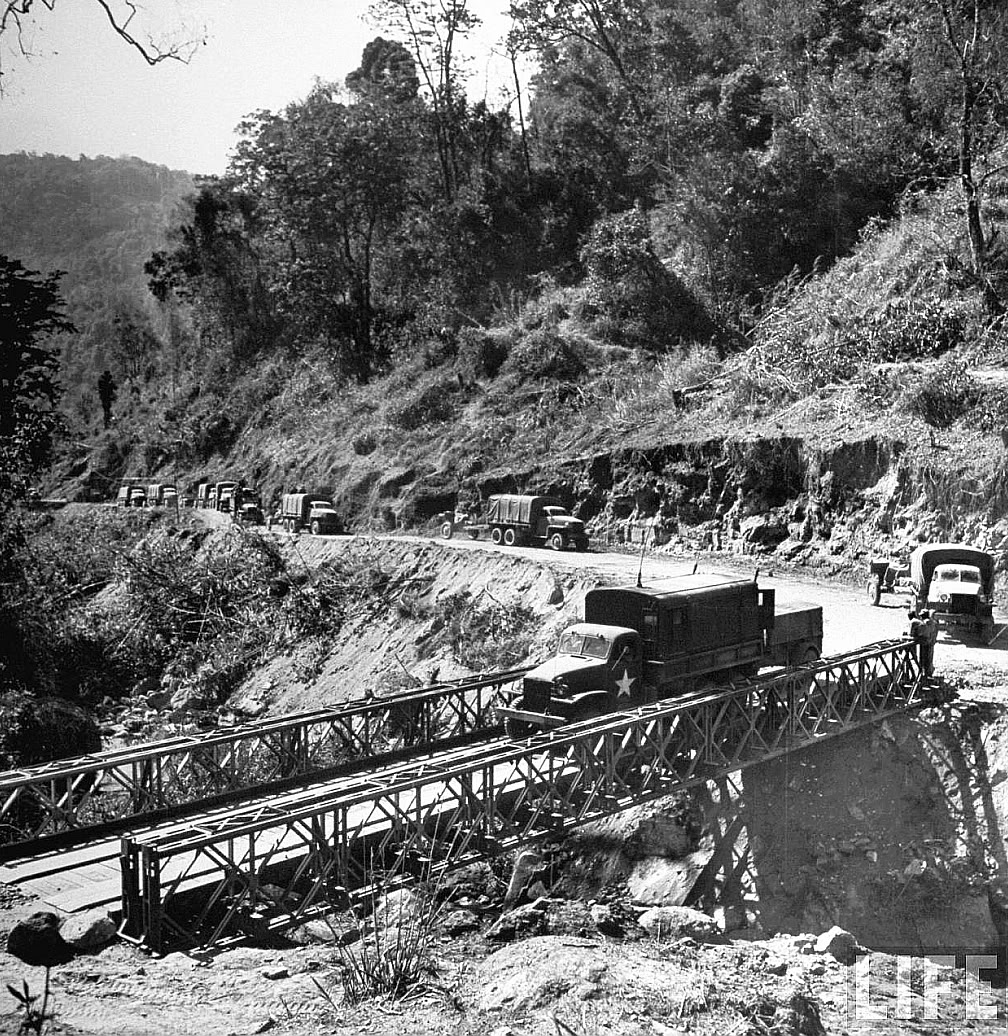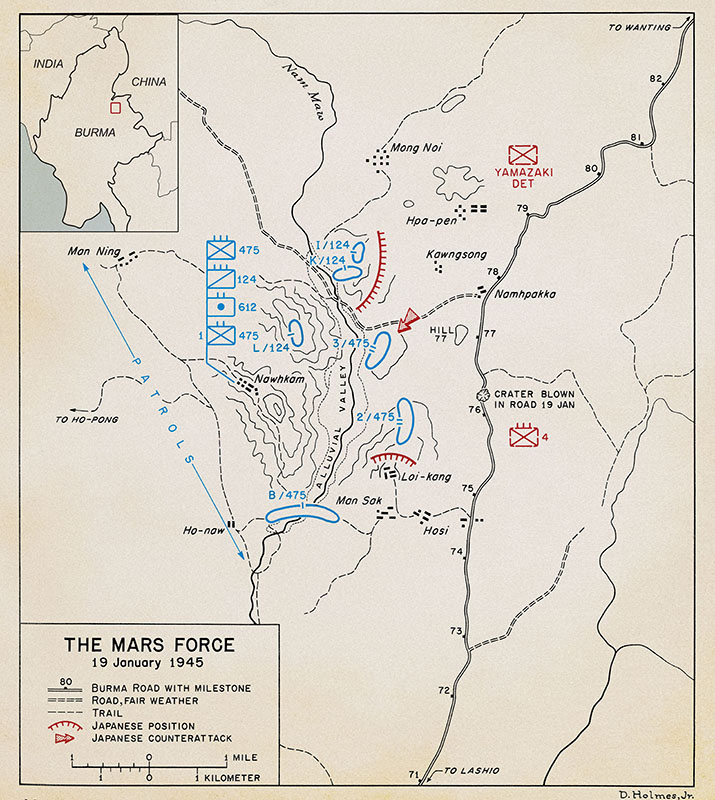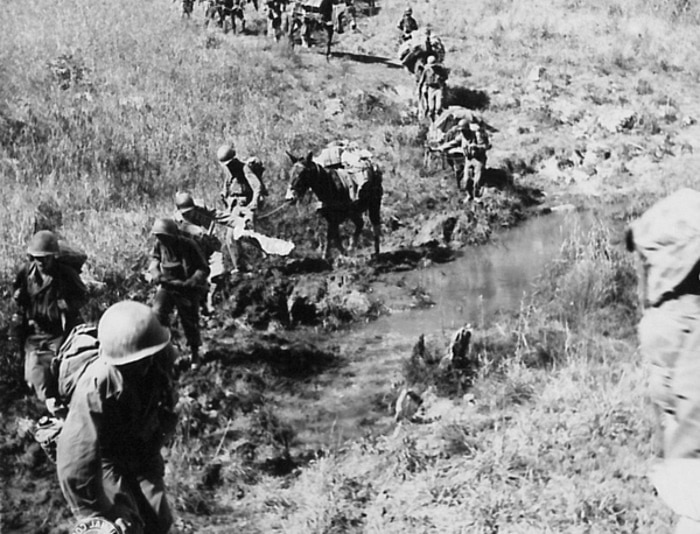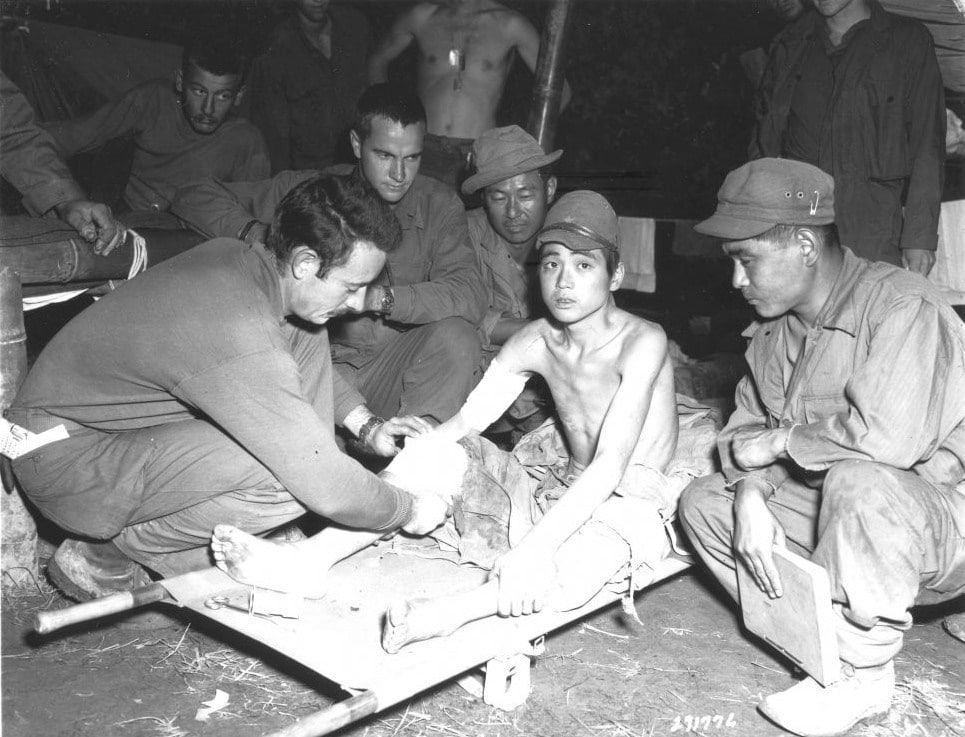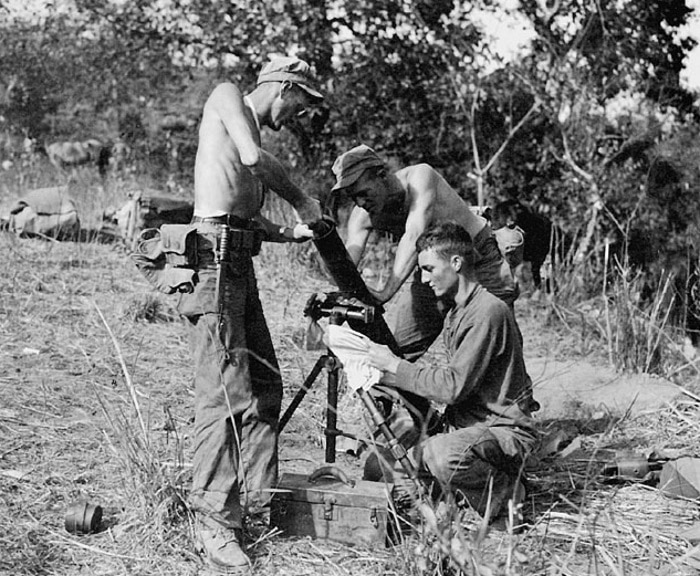Document Source: Operation of Troop A, 124th Cavalry Regiment, Mars Task Force, in the Battle of Nam-Pak-Kha, Jan 28, 1945, to Feb 2, 1945, Central Burma Campaign. Personal Experience of a Troop Commanding Officer, Maj William A. Locke
(Definitive version Doc Snafu November 7, 2022)
Late in February 1944, the first phase of the Allied Operation for the reconquest of Burma began. The purpose of this Allied offensive was to regain control of the land routes across Burma so that supplies could be transported to China. The enormous tonnage of supplies that were required of the American and British Allies in order to keep China in the war had to be transported along vast distances over sea, land, and air. With the Japanese controlling all of the seaports of China, as well as the whole of French Indo-China, Thailand, and Burma, our Chinese Allies were sealed off by land and sea. This threw a tremendous strain on the air force which attempted to sustain the supply flow until a sea and land route could be re-established. At the beginning of the campaign (related in this archive), supplies were being flown from India, across Burma, and into the interior of China. The objective of this campaign was to drive the enemy out of Burma so that the land and sea routes to China could be opened.
 This operation was planned in late 1943. At the time there were known to be a total of five Japanese Divisions in Burma. The first phase, which was to be carried out by American and Chinese forces operating from bases in the vicinity of Ledo on the northwest border of Burma, had as its objective the capture of Myitkyina, the northern terminus of the Myitkyina – Mandalay railroad.
This operation was planned in late 1943. At the time there were known to be a total of five Japanese Divisions in Burma. The first phase, which was to be carried out by American and Chinese forces operating from bases in the vicinity of Ledo on the northwest border of Burma, had as its objective the capture of Myitkyina, the northern terminus of the Myitkyina – Mandalay railroad.
The accomplishment of this first phase would permit the building of a road from Ledo to the Burma Road and thus facilitate the overland transportation or supplies to China while succeeding phases of the campaign were being accomplished. At the conclusion of the campaign, supplies could again be brought in by sea to the Port of Rangoon, carried by rail to Lashio, and thence over the Burma Road to China as had been the case previous to the occupation of Burma a by the Japanese.
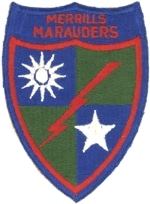 The first phase of this campaign was accomplished by August 3, 1944, with the fall of Myitkyina. The American and Chinese forces with which this operation was conducted consisted of one American RCT (Regimental Combat Team), the 5307th Composite Unit (Provisional), popularly known as Merrill’s Marauders, and the Chinese 22-ID and 38-ID. The Marauders spearheaded the advance of this force all the way through northern Burma, and during the assault on the strongly held objective. This was the last offensive action of the Marauders, for, with the end of this phase of the Burma Campaign, disease, fatigue, malnutrition, and the normal attrition of jungle fighting had decimated their ranks. With a small cadre of the original Marauders and many replacements, the unit was reorganized and re-designated as the 475th Infantry Regiment.
The first phase of this campaign was accomplished by August 3, 1944, with the fall of Myitkyina. The American and Chinese forces with which this operation was conducted consisted of one American RCT (Regimental Combat Team), the 5307th Composite Unit (Provisional), popularly known as Merrill’s Marauders, and the Chinese 22-ID and 38-ID. The Marauders spearheaded the advance of this force all the way through northern Burma, and during the assault on the strongly held objective. This was the last offensive action of the Marauders, for, with the end of this phase of the Burma Campaign, disease, fatigue, malnutrition, and the normal attrition of jungle fighting had decimated their ranks. With a small cadre of the original Marauders and many replacements, the unit was reorganized and re-designated as the 475th Infantry Regiment.
ORGANIZATION AND MISSION
The second phase of the Central Burma Campaign was started from Myitkyina on November 15, 1944, and was assigned to a specially organized American Force, the Mars Task Force. This task force was composed of one Hqs Co, the 475th Infantry Regiment (formerly the Marauders), and the 124th Cavalry Regiment which was to fight as infantry. The organization of the two regiments differed as one was standard infantry and the other standard cavalry but their equipment was the same. Organic transportation was by pack mules only, and the force was to be resupplied by airdrop. It was necessary to reorganize the 124th Cavalry Regiment, as they arrived in the theater under-strength, and the equipment which was issued to them for the operation could not be properly employed under a standard horse cavalry organization. The result was a regiment consisting of three squadrons which were in effect three small but complete combat teams, each with a battery of 75-MM pack howitzer field artillery attached. The heavy weapons were contained in the headquarters troop of the squadron, and in the headquarters platoon of each line troop. The service and heavy weapons troops of the regiment were disbanded and the personnel was used to strengthen the squadrons.
Each rifle platoon had one mortar squad armed with one 60-MM mortar. This mortar was the modified type equipped with a small base plate and a lanyard trigger. This permitted the weapon to be fired on a horizontal plane to give the shell a flat trajectory. It proved to be extremely effective against enemy bunkers that were too close to be reached by the high-angle tire. Training of the force was characteristic of that of the jungle and emphasized small-unit leadership and teamwork within small units. Discipline was emphasized to insure efficient and aggressive action on the part of small units and individuals when acting independently.  Live ammunition was used in all combat problems to familiarize individuals with the effectiveness of their own and supporting fires. The 475-RCT left Myitkyina on Nov 15, 1944, moving south.
Live ammunition was used in all combat problems to familiarize individuals with the effectiveness of their own and supporting fires. The 475-RCT left Myitkyina on Nov 15, 1944, moving south.
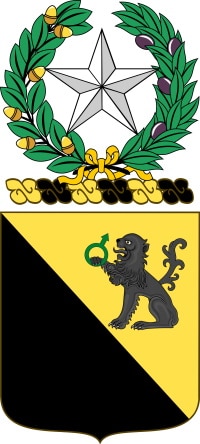 During this time the 124th Cavalry Regiment (Dismounted) continued training. It was not until December 16, the day the Battle of the Bulge started in Belgium, that the 124-CAV started on its mission objective. It moved in three squadron serials, each a day apart. The enemy situation was very vague at this time, as the Japanese had moved south after the fall of Myitkyina, and contact with them had been lost. Consequently, the first objective of the task force was to develop the situation. A specific mission would be assigned later when the enemy situation was better known. For the present, it was to move south on a prescribed route of march. Two weeks after leaving its base at Myitkyina, the 124-CAV received its definite mission. It was to cut the Burma Road in the vicinity of Namphakka. In doing this it was to go by way of Bahmo and Mong Wi, Rendez-vouing with the 475-RCT in Mong Wi. By January 11, 1945, the two regiments and the forward command post of the Mars Task Force were assembled in Mong Wi.
During this time the 124th Cavalry Regiment (Dismounted) continued training. It was not until December 16, the day the Battle of the Bulge started in Belgium, that the 124-CAV started on its mission objective. It moved in three squadron serials, each a day apart. The enemy situation was very vague at this time, as the Japanese had moved south after the fall of Myitkyina, and contact with them had been lost. Consequently, the first objective of the task force was to develop the situation. A specific mission would be assigned later when the enemy situation was better known. For the present, it was to move south on a prescribed route of march. Two weeks after leaving its base at Myitkyina, the 124-CAV received its definite mission. It was to cut the Burma Road in the vicinity of Namphakka. In doing this it was to go by way of Bahmo and Mong Wi, Rendez-vouing with the 475-RCT in Mong Wi. By January 11, 1945, the two regiments and the forward command post of the Mars Task Force were assembled in Mong Wi.
GENERAL SITUATION
At Mong Wi, the two regiments were given their specific missions. The Burma Road in the Task Force objective area was dominated by two hill masses about three miles apart. The 475-IR was assigned the southern hill mass, and the 124-CAV was given the northern hill mass. Both of these regimental objectives were known to be occupied by the enemy, but the strength was not known. The terrain would not permit the combat teams to move towards their objectives on a broad front, so they resorted to their routine method of advance: squadrons or battalions moving a day apart on the same trail. The 3/124 moved out of Mong Wi on January 18, a day after the 1/475-IR. It was followed on January 19, by the 1/124-CAV while the 2/124-CAV remained in Mong Wi as Task Force reserve.
The approach to the two objectives took the regiments over the most difficult terrain they had encountered. It required four days to march twenty-one miles, the point at which contact was made with the enemy. About mid-morning of the fourth day out of Mong Wi, the 1/124-CAV heard heavy firing from the southeast. This was in the direction of the 475-IR. After a short time, the firing of small arms decreased but artillery continued. It was learned later that the 1/475-IR had struck a trail block and that the artillery which had gone in position to support the battalion continued firing to interdict traffic on the Burma Road. At noon it was learned that the 3/124-CAV, a day’s march ahead of the 1/124-CAV, had been stopped the day before by heavy enemy resistance. During the night the 3/124-CAV had been subject to a strong attack on their perimeter and had taken many casualties. The 3/124-CAV Commander considered his position untenable for the coming night unless he could be given reinforcements. The sound of the 3/124-CAV fight had not been heard by the 1/124-CAV zone because of the peculiar acoustics caused by the cross-compartment arrangement of the hills. The enemy situation was developing in front of both regiments.
REINFORCEMENT OF THE 3/124-CAV
Troop A and Troop B, which were leading the 1/124-CAV column, were ordered to make a forced march to reinforce the 3/124-CAV which was in contact with the enemy. The commanding officer of Troop A was given command of both troops for this march. No information as to the strength or exact location of the enemy was available to the Troop A Commander as they started out. The location of the 3/124-CAV was definitely known, but there was no knowledge as to how their battle positions were drawn up. It was not even known whether the 3/124-CAV was fighting in a perimeter or a line position. Only enough time to water the animals was allowed, and then the two troops moved out.
A mapping study of the route to the 3/124-CAV showed that about midway a deep canyon would have to be crossed. To prevent loss of time in crossing this obstacle, the commander of Troop A went ahead of the main body with a recon party. When this recon party arrived at the edge of the canyon, they found a similar party there under the executive officer of the 3/124-CAV. It was sent there for the same purpose. The crossing site suggested by the 3/124-CAV executive officer was five miles off the route of march. This was discouraging, for the time was important if the reinforcement troops were to reach the 3/124-CAV by night.
The sergeant in charge of recon for the commander of Troop A asked that he be allowed to search for a shorter route while waiting for the arrival of the main body. Permission was granted. This capable sergeant plunged into the thick brush of the downward slope of the canyon. The problem was to find a crossing that the pack mules could negotiate. Before the first troops arrived, he had found a route that was hazardous and would require about an hour’s work for the leading platoon in clearing the brush and cutting down the most precipitous slopes. Even so, it was better than a ten-mile march to take advantage of a better crossing.
The leading platoon was immediately put to work on this project, and while this work was in progress, the remainder of the main body fed men and animals. It was now early afternoon. The work was rotated so that all of the men had a chance to eat and get a short rest. The delay caused by this crossing only amounted to about forty-five minutes. With the canyon crossing safely behind them, the reinforcing troops knew that they would reach the 3/124-CAV far ahead of the planned schedule. The commander of Troop A went ahead with the executive officer of the 3/124-CAV to contact the commander of the squadron needing the reinforcements.
Upon arrival at the 3/124-CAV, it was found that the situation had eased considerably for the squadron. The enemy did not seem to be showing any strength against the positions at this time. The reinforcement was timely, however, the squadron was overextended in order to completely hold the objective. With the arrival of A and B Troops, it was possible to strengthen the perimeter and to place I Troop, which had been hardest hit the night before, within the perimeter as a reserve. This perimeter was under good enemy observation. Seeming to realize that they had been outmaneuvered, the Japs made no attack that night. With the arrival of the remainder of the 1/124-CAV on January 22, the entire position was reorganized, and A Troop was given the mission of establishing trail blocks on the trails leading into the position from the north.
By nightfall, the regiments of the Task Force were disposed of in defensive positions. The 475-IR on the right had encountered strong organized enemy resistance and had committed two of its battalions in an effort to attain its objective. Considerable enemy traffic could be observed on the Burma Road, but it could not be determined whether or not this indicated an attempt on the part of the Japs to reinforce their troops in contact with the task force.
SPECIAL SITUATION
At about 1600, on January 22, the positions for the trail blocks had been selected. While these were being established at top speed to have them ready by darkness, the troop commander dispatched two patrols of one squad each to recon to the north. Nothing was known of the enemy situation in this area, and it was desirable to know the strength which the enemy could throw against these blocking positions. One patrol was to advance as far as the village of Mong Noi. The other was to go as far as the village of Namogun, and there split; half returning by the trail leading directly south from this village, and the other half returning by a trail which ran south from a point five hundred yards to the west of Namogun.
The enemy situation did not remain a mystery for long. Twenty minutes after starting out, the Mong Noi patrol was engaged in a firefight. The commander of Troop A could tell by the sounds of the weapons that the Japanese were delivering a preponderance of the fire. The exchange of fire lasted for about five minutes and then died out. In due time a runner came back from this patrol to give the story. The patrol was fired upon as it came adjacent to a hill to the east of the trail. As the patrol returned the fire, they could observe several Japanese estimated to be about a platoon, rush over the crest of the hill from which the fire was coming, and occupy prepared bunkers on the forward slope of the hill.
As the fighting was not his mission just then, the resourceful NCO in charge of the patrol had broken off the firefight after causing the enemy to show his strength, then bypassed the exposed portion of the trail by detouring through the jungle to the west of the trail. His report ended by stating that he was continuing on his mission to Mong Noi. This and other similar evidence of his leadership ability in this campaign. This resourceful NCO was given a battlefield promotion.
Hurrying to take advantage of the short remaining time of daylight, the Troop A Commander took his artillery observer and 81-MM mortar observer along with a few riflemen for security and hurried to a position on the trail where he could see the enemy’s strong point. Upon arrival, he found two men of the Mong Noi Patrol whom the NCO had left to keep the strong point under observation. A good observation post was found on a hill line which formed a semi-circular ring around the high point occupied by the enemy. This brought the American party within two hundred and fifty yards of the leading positions of the Japanese. A deep and heavily wooded draw separated the two forces. The hill occupied by the observation party of Troop A and the hill fortified by the enemy were both important terrain features, as both gave almost perfect observation of the area occupied by the 1/124-CAV and 3/124-CAV on an adjacent ridge in the distance. It will never be understood why the Japs did not occupy both of these terrain features.
Full details of this situation were sent back to the 1/124-CAV, and the commander of Troop A began making plans to seize the enemy positions as he felt that an order to attack would be forthcoming. On his own initiative, he had the artillery and the mortars register on the enemy position. The Japanese gave no reaction to this registration. The observation post was manned for the night, and wire was laid to the position after dark.
The Commander of Troop A now made his way to the 1/124-CAV CP to give a detailed report and to offer a plan for taking the enemy positions. The squadron commander appreciated the aggressive action and plans of Troop A but was forced to hold everything on standby as the 1/124-CAV was now in regimental reserve, and as such was not allowed to commit even a part of its force. Instead of returning to his troop with approval for his attack plans the Commander of Troop A returned with orders to maintain observation of the enemy position and to initiate no further patrol action without specific orders from the squadron. Thus the situation remained frozen for seven days until January 29, when the 2/124-CAV arrived upon the scene from Mong Wi and relieved the 1/124-CAV as the regimental reserve. The 1/124-CAV ordered then the attack to be launched at 1000 on that day.
PLAN OF ATTACK
The 613th Field Artillery Battalion was placed in direct support of the troop and a section of heavy machine guns was attached from the squadron headquarters troop. The plan of attack was as follows: the assault was to be made from the west by the 1st Platoon and the 2nd Platoon abreast; the 1st Platoon on the left. The 3rd Platoon and the section of heavy machine guns were to establish a base of fire from a point on the crescent ridge directly north of the Japanese positions. The artillery was to open the attack with fire upon the positions. At the same time, the 81-MM mortars were to open fire on the reverse slope of the enemy-held hill to prevent reinforcement of the position and to neutralize possible mortar positions. The base of fire was to remain silent and hold their fire until the leading elements of the assault platoons approached the leading enemy positions, then they were to open fire ahead of the assaulting platoons and keep the enemy pinned down.











